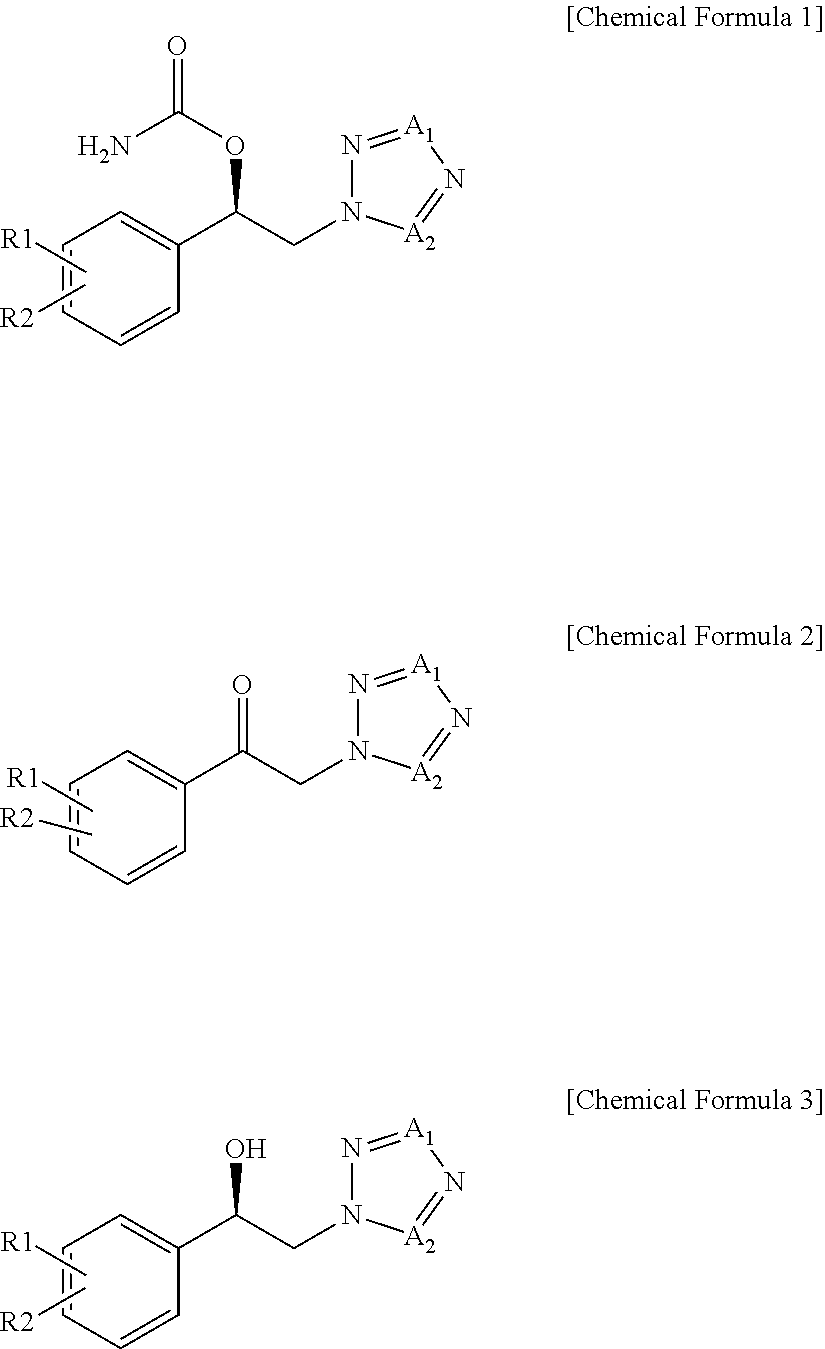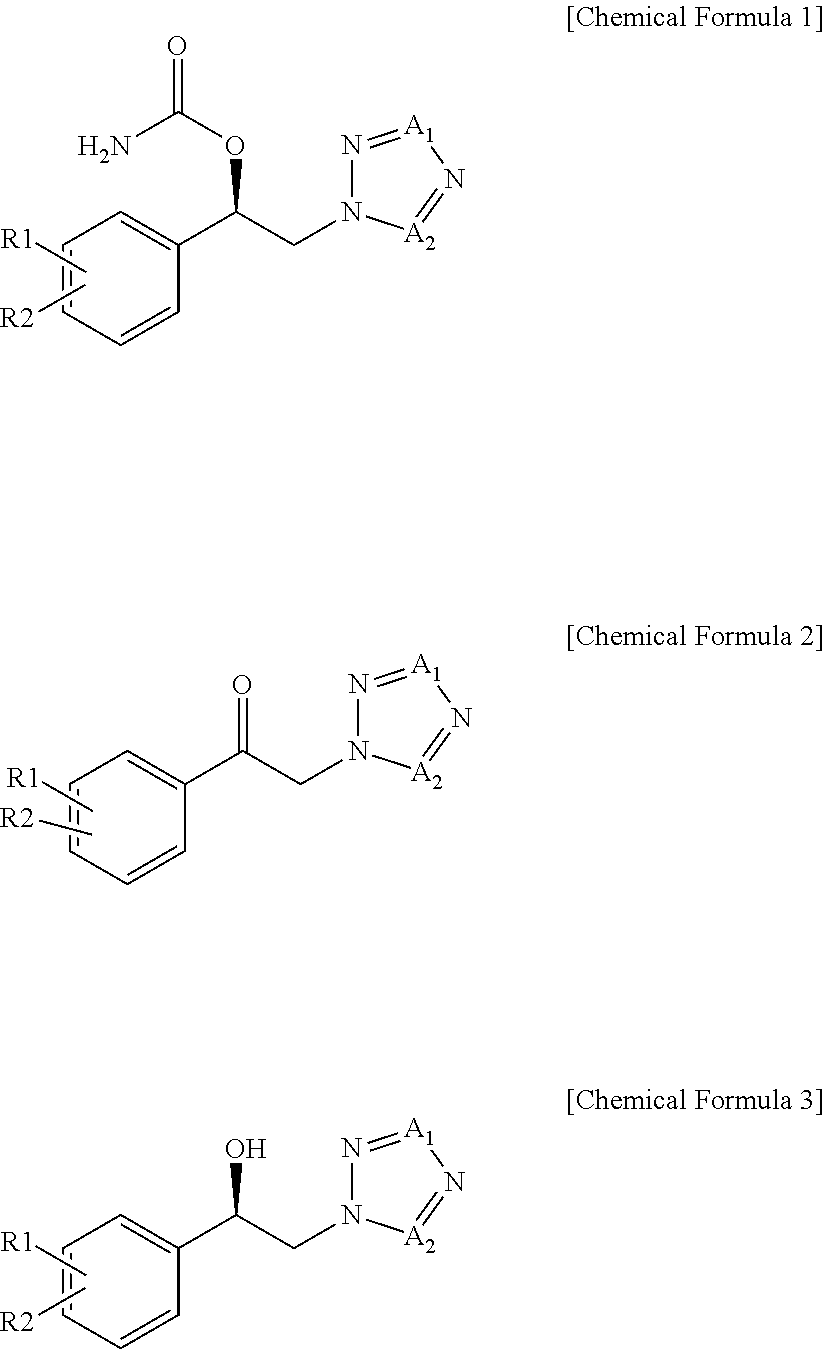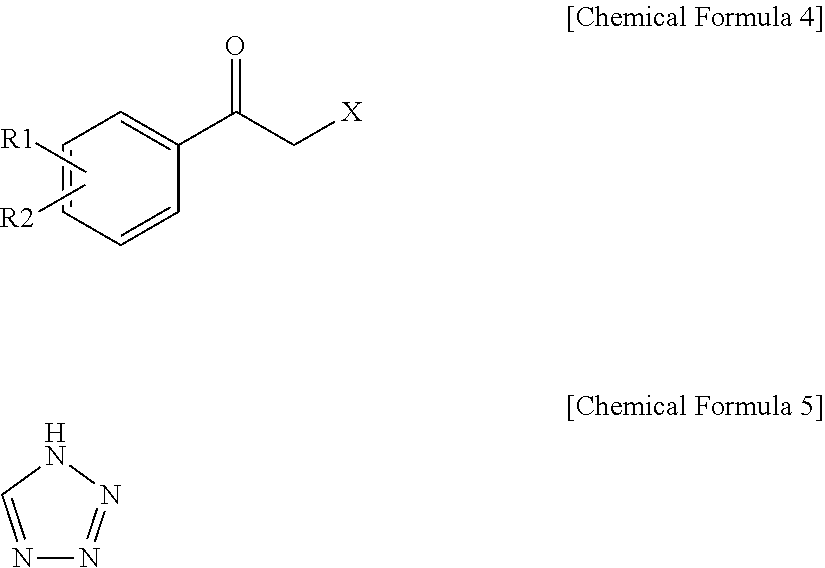Method for Preparation of Carbamic Acid (R)-1-Aryl-2-Tetrazolyl-Ethyl Ester
a technology of aryl oxirane and carbamic acid, which is applied in the field of preparation of carbamic acid (r)1aryl2tetrazolylethyl ester, can solve the problems of low production yield of individual positional isomers, high cost of r)-2-aryl-oxirane, and high risk of runaway reaction in ring opening reaction
- Summary
- Abstract
- Description
- Claims
- Application Information
AI Technical Summary
Benefits of technology
Problems solved by technology
Method used
Image
Examples
preparation example 1
Preparation of 1-(2-chlorophenyl)-2-(1,2,3,4-tetrazol-1-yl)ethan-1-one
To a suspension of 2-bromo-2′-chloroacetophenone (228.3 g, 0.978 mol) and potassium carbonate (161.6 g, 1.170 mol) in acetonitrile (2000 mL) was added a 35 w / w % 1H-tetrazole dimethylformamide solution (215.1 g, 1.080 mol) at room temperature. These reactants were stirred for 2 h at 45° C. and distilled under reduced pressure to remove about 1500 mL of the solvent. The concentrate was diluted in ethyl acetate (2000 mL) and washed with 10% brine (3×2000 mL). The organic layer thus separated was distilled under reduced pressure to afford 216.4 g of an oily solid residue. To a solution of the solid residue in ethyl acetate (432 mL) was slowly added heptane (600 mL). The precipitate thus formed was filtered at room temperature and washed to yield 90.1 g (0.405 mol) of 1-(2-chlorophenyl)-2-(1,2,3,4-tetrazol-1-yl)ethan-1-one (hereinafter referred to as “1N ketone”).
1H-NMR (CDCl3)□8.87 (s, 1H), d7.77 (d, 1H), d7.39-7.62 ...
preparation example 2
Preparation of 1-(2-chlorophenyl)-2-(1,2,3,4-tetrazol-2-yl)ethan-1-one
After the filtration of Preparation Example 1, the filtrate was concentrated and dissolved in isopropanol (100 mL), and to which heptane (400 mL) was then added to complete the crystallization. Filtering and washing at 5° C. afforded 1-(2-chlorophenyl)-2-(1,2,3,4-tetrazol-2-yl)ethan-1-one (hereinafter referred to as “2N ketone”) as a solid. 94.7 g (0.425 mol).
1H-NMR (CDCl3) d8.62 (s, 1H), d7.72 (d, 1H), d7.35-7.55 (m, 3H), d6.17 (s, 2H)
preparation example 3
Preparation of Alcohol Compound of (R)-Configuration by Enantioselective Enzymatic Reduction Via Various Oxidoreductases
The following four solutions were prepared as follows:
Enzyme Solution 1
Competent Escherichia coli StarBL21(De3) cells (Invitrogen) were transformed with the expression constructs pET21-MIX coding for oxidoreductase SEQ ID NO 1. The Escherichia coli colonies transformed with the resulting expression constructs were then cultivated in 200 mL of LB medium (1% tryptone, 0.5% yeast and 1% sodium chloride) with 50 micrograms / mL of ampicillin or 40 micrograms / mL of kanamycin, respectively, until an optical density of 0.5, measured at 550 nm, was achieved. The expression of the desired recombinant protein was induced by the addition of isopropylthiogalactoside (IPTG) to a concentration of 0.1 mM. After 16 hours of induction at 25° C. and 220 rpm, the cells were harvested and frozen at −20° C. In the preparation of the enzyme solutions, 30 g of cells were resuspended in 150...
PUM
| Property | Measurement | Unit |
|---|---|---|
| Fraction | aaaaa | aaaaa |
| Fraction | aaaaa | aaaaa |
| Fraction | aaaaa | aaaaa |
Abstract
Description
Claims
Application Information
 Login to View More
Login to View More - R&D
- Intellectual Property
- Life Sciences
- Materials
- Tech Scout
- Unparalleled Data Quality
- Higher Quality Content
- 60% Fewer Hallucinations
Browse by: Latest US Patents, China's latest patents, Technical Efficacy Thesaurus, Application Domain, Technology Topic, Popular Technical Reports.
© 2025 PatSnap. All rights reserved.Legal|Privacy policy|Modern Slavery Act Transparency Statement|Sitemap|About US| Contact US: help@patsnap.com



